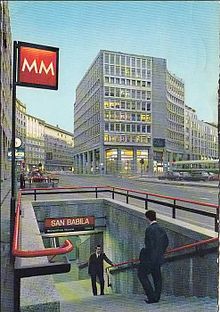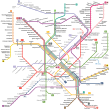|
Milan Metro Line 1
Line 1 (Linea Uno in Italian) is the first underground rapid transit line built in Milan, Italy. It is part of the Milan Metro and it is operated by ATM. Works on the line began in 1957, and the first part was opened on 1 November 1964,[4][5] running from Sesto Marelli to Lotto station. The line is also called Red Line (Linea Rossa in Italian), as it is visually identified by red signs. Due to its premiership, the line gave its red color to the Milan Metro logo. RouteThe line runs underground from the northern suburb of Sesto San Giovanni to the city centre, then to the western district with two different branches, one northwest to Rho, the other to the west to Bisceglie. It is 27 km (17 mi) long and serves 38 underground stations.[6] Key points served by the line are Duomo, considered the center of Milan; Castello Sforzesco (with Cairoli station); Cadorna, one of the busiest stations in Milan and in Italy; Corso Buenos Aires (with stations Porta Venezia, Lima and Loreto), an important shopping street; and Rho Fiera, one of the largest fairgrounds in the world.[7]
History  On 6 April 1952 the city administration asked for a project of a metro system and on 6 October 1955 a new company, Metropolitana Milanese, was created to manage the construction of the new infrastructure.[8] The project was funded with ₤ 500 million from the municipality and the rest from a loan. The construction site of the first line was opened in viale Monte Rosa on 4 May 1957.[8] Stations on the new line were designed by Franco Albini-Franca Helg architecture studio. Bob Noorda designed the famous wayfinding and signage system.[8] At first, stations were designed without the mezzanine floor. However, these were added to the final design to allow street crossing and the use of gates to collect tickets. The line from Lotto to Sesto Marelli (21 stations) opened on 1 November 1964, after seven years of construction works.[9] Rolling stockThere are 3 types of trains running on the line: revamped original trains, AnsaldoBreda Meneghino trains and the new Leonardo train introduced in 2015. The original first series trains were phased out between 2014 and 2015. The track gauge is the 1,435 mm (4 ft 8+1⁄2 in) standard gauge. The entire line is electrified by means of a third or fourth rail at 750 V DC.[10] Among the 63 trains running on the line, 20 entered service between 1964 (opening of the line) and 1970. Those trains are planned to be replaced by new Meneghino trains in the next few years. There are 17 Meneghino trains already operational as of March 2012.[2] In 2015, the Leonardo trains were introduced, replacing the original rolling stock, which was subsequently retired and dismantled.[11] These new trains fully replaced the older, non-upgraded series still operating on Line 1. On November 17, 2024, the first of 21 trains produced by Hitachi Rail at the Reggio Calabria plant was delivered for Line 1.[12][13][14] These trains are set to completely replace the refurbished traditional sets. Their entry into service is scheduled for 2025.[12] ExtensionAn extension towards the north from Sesto Primo Maggio to Monza Bettola is currently under construction. It is expected to be completed by 2023.[15] The new section will be 1.9 km (1.2 mi) long with 2 stations (Sesto Restellone and Monza Bettola), entirely underground. The total cost will be €206 million.[16]
An extension of the western branch from Bisceglie towards the city limits has been approved. The new stations will be located at Baggio, via Valsesia and at Quartiere Olmi. The national government will provide €210 million, while the total cost is estimated at €350 million.[17]
Gallery
Notes
References |
||||||||||||||||||||||||||||||||||||||||||||||||||||||||||||||||||||||||||||||||||||||||||||||||||||||||||||||||||||||||||||||||||||||||||||||||||||||||||||||||||
Portal di Ensiklopedia Dunia






